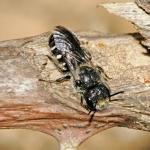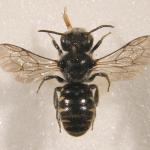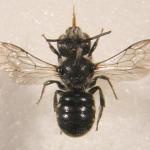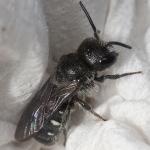Trachusa sexpunctata SITSCHEGLOFF 1826; Stelis octomaculata SMITH 1843; Stelis sexsignata COSTA 1858;
A rare cleptoparasitic bee which can sometimes be reared in small numbers from the stem-nests of its host, the megachiline bee Hoplitis claviventris.
Widely distributed in southern England and East Anglia, Wales and in Merseyside (South Lancashire). It can be expected wherever H. claviventris is established. Widespread in Europe, from Fennoscandia south to the Pyrenees, and east to Greece and Russia (east of the Urals).
Listed as Rare (RDB3) in Shirt (1987). This species has been recorded from about a dozen post-1970 10 km squares and is classified as Rare (RDB3) by Falk (1991).
Both inland and coastal sites, including heathland, chalk grassland, open broad-leaved woodland, coastal dunes and landslips.
Univoltine; end of May to late August.
In Britain, a cleptoparasite of H. claviventris, but on the Continent it is additionally associated with the closely related H. leucomelana, a species which is probably extinct in Britain, with no record in the wild for nearly two hundred years (it has been imported more recently from the Continent on at least one occasion). S. ornatula has been reared frequently from bramble (Rubus fruticosus agg.), rose (Rosa sp.) and ragwort (Senecio jacobaea) stem-nests of H. claviventris. The Stelis cocoons can readily be distinguished from those of its host species by their dense silken walls (through which the prepupae cannot be seen) and the presence of a conspicuous apical nipple; the H. claviventris cocoons differ by having thinner silken side walls which are more or less transparent, and a broadly rounded apex which lacks a nipple-like projection.
Bird's-foot-trefoi (Lotus corniculatus)l, cinquefoil (Potentilla sp.), ragwort (Senecio jacobaea), fleabane (Pulicaria dysenterica) and hawk's-beard (Crepis sp.).
The chalcid wasp Pteromalus apum has been reared from a cocoon of S. ornatula.
Profile written: 1998
Proofed: February 2012





